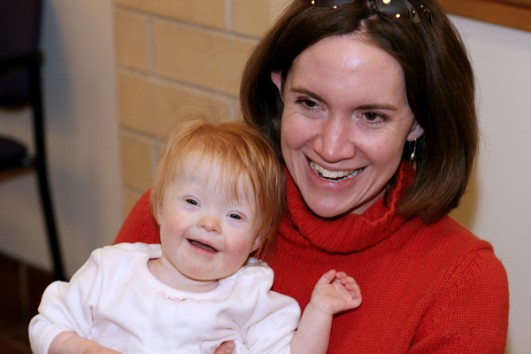দুই সিনড্রোমের গল্প
Commentary by Michelle Sie Whitten
Executive Director, Global Down Syndrome Foundation
 When I talk to parents or professionals, I often give examples of discrimination against individuals with Down syndrome – the Federal Government (lack of funding); the medical community (refusal to provide medical solutions, uninformed bias for termination); educators (not in my classroom!) and society at large (are they dangerous?). Inevitably people ask me why we as a society have allowed so much discrimination against these individuals. And the answer is the same underlying motivation for any bigotry or prejudice: ignorance.
When I talk to parents or professionals, I often give examples of discrimination against individuals with Down syndrome – the Federal Government (lack of funding); the medical community (refusal to provide medical solutions, uninformed bias for termination); educators (not in my classroom!) and society at large (are they dangerous?). Inevitably people ask me why we as a society have allowed so much discrimination against these individuals. And the answer is the same underlying motivation for any bigotry or prejudice: ignorance.
Most people who discriminate against people with Down syndrome do so because they have been provided outdated, inaccurate information about the condition. The perpetuation of erroneous assumptions about people with Down syndrome – they are unpredictable, uneducable, unemployable burdens on society – can be traced back to what I call “The Story of Two Syndromes.”
The Old Syndrome
Before the 1980s, life for people with Down syndrome was too often a Dickensian nightmare.
Before the 1980s, the overwhelming majority of people with Down syndrome in the United States were placed in institutions, often times as infants or young children. Pictures of these institutions and their “inmates” show us bedlam – cruel and unusual punishment for innocents whose only crime is to have been born differently-abled. Because of neglect, abuse, and lack of access to education and medical care, people with Down syndrome would die an early death in these institutions. In the 1980s the average life expectancy for a person with Down syndrome was only 28 years old.
During what I consider the dark ages for people with Down syndrome in this country, most professionals considered it  impossible for people with Down syndrome to learn how to speak properly, let alone read and write. It was assumed that people with Down syndrome would not walk properly, let alone participate in sports. They most likely could not dress, feed or take care of themselves, and were determined a burden to a marriage, siblings and a family. They were not allowed to attend public schools and most Americans believed they should not be allowed in public spaces such as movie theaters, malls or parks. They would die an early death and it was not blamed on institutionalization, it was simply Down syndrome.
impossible for people with Down syndrome to learn how to speak properly, let alone read and write. It was assumed that people with Down syndrome would not walk properly, let alone participate in sports. They most likely could not dress, feed or take care of themselves, and were determined a burden to a marriage, siblings and a family. They were not allowed to attend public schools and most Americans believed they should not be allowed in public spaces such as movie theaters, malls or parks. They would die an early death and it was not blamed on institutionalization, it was simply Down syndrome.
But society began to shift during the 1970s and 1980s – people with Down syndrome and other differently-abled populations were deemed “human” and institutions inhumane. The institutions were closed down, and it was now expected that people with Down syndrome would live at home, go to school and have fundamental human and civil rights.
The New Syndrome
Today, the average lifespan of someone with Down syndrome is 60 years old. In the last three decades since the dismantling of institutions, and with the advent of legislation including the Individuals with Disabilities Education Act and the American with Disabilities Act, lifespan is not the only thing that has dramatically changed for people with Down syndrome.
People with Down syndrome now live at home (versus an institution). Their IQs have increased 20 points and the overwhelming majority will learn how to read and write. Most are attending public school and some are graduating with a typical degree.
By and large, people with Down syndrome now live at home (versus an institution). Their IQs have increased 20 points and the overwhelming majority will learn how to read and write. Most are attending public school and some are graduating with a typical degree. There are a handful who have gone on to achieve college degrees. More and more are holding down jobs.
These gains have been made because of the human and civil rights movement for the differently-abled that various individuals and organizations fearlessly led in the 1970s and the 1980s. They have NOT been made because of our government’s investment into basic, clinical or developmental research for people with Down syndrome.
   
The Solution
When the National Institutes of Health does not fund research that will improve the lives of people with Down syndrome at a comparable level as other conditions or diseases, that is discrimination.
When the local service provider refuses to service people with Down syndrome because they live too close together (i.e. Not in My Neighborhood legislation), that is discrimination.
When a medical professional tells you that the chronic throat, eye, or whatever condition your child has is “just Down syndrome” and sends you home without proper medical care, that is discrimination.
When an educator tells you that their public school is “not a good fit for your child with Down syndrome”, that is discrimination AND illegal.
Our neighbors, our professionals and our government officials are not mean-spirited people. They are simply people who believe that Down syndrome is the “old” syndrome and they are making recommendations based on this. After all, who would wish a life of neglect and abuse in an institution on anyone?
It is clear that in addition to advocacy, it is our responsibility to educate our government, our professionals and our society, including those in the Down syndrome community. And we must do so in an evidence-based, accurate, and professional manner. Only through advocacy and education will we be able to truly ensure human and civil rights for individuals with Down syndrome in this country and beyond. This is the work of Global Down Syndrome Foundation. Please join us!


 আমাদের অনুপ্রেরণামূলক এবং যুগান্তকারী ভিডিও এবং ফটোগুলি উপভোগ করুন৷ আমাদের শিশু এবং স্ব-উকিল সুন্দর এবং উজ্জ্বল!
আমাদের অনুপ্রেরণামূলক এবং যুগান্তকারী ভিডিও এবং ফটোগুলি উপভোগ করুন৷ আমাদের শিশু এবং স্ব-উকিল সুন্দর এবং উজ্জ্বল! নিশ্চিত করুন যে আপনার স্থানীয় প্রতিনিধিরা কংগ্রেসনাল ডাউন সিনড্রোম টাস্ক ফোর্সে আছেন।
নিশ্চিত করুন যে আপনার স্থানীয় প্রতিনিধিরা কংগ্রেসনাল ডাউন সিনড্রোম টাস্ক ফোর্সে আছেন।